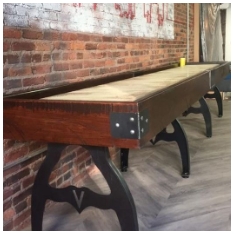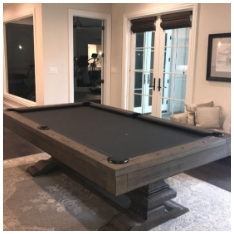When it comes to selecting a pool table, enthusiasts and professionals alike often gravitate towards slate tables. But what makes slate pool tables the gold standard in billiards? This article delves into the key reasons why slate is the preferred material for high-quality pool tables.
The Superiority of Slate in Pool Tables
Understanding Slate as a Material
Slate is a fine-grained, homogeneous metamorphic rock derived from an original shale-type sedimentary rock composed of clay or volcanic ash. It is renowned for its durability and smooth texture, which makes it an ideal surface for pool tables. Slate is used in a variety of applications, from roofing to flooring, but its properties are particularly well-suited to billiards.
The Historical Significance of Slate in Billiards
The use of slate in pool tables dates back to the 18th century. The transition from wooden tables to slate marked a significant advancement in the game. Early wooden tables would warp and become uneven over time, whereas slate provided a consistently flat and stable playing surface. This historical shift laid the foundation for modern billiards, elevating the game to new levels of precision and enjoyment.

Why Slate Became the Preferred Choice
The main reason slate became the preferred choice for pool tables is its ability to remain flat and true. Unlike wood, which can warp with changes in humidity and temperature, slate remains unaffected by environmental conditions. This stability ensures a level playing surface, which is crucial for the accuracy of shots.
The Craftsmanship Behind Slate Pool Tables
The Process of Crafting a Slate Pool Table
Creating a slate pool table is an intricate process that involves precision and skill. The raw slate is extracted from quarries and then cut into slabs. These slabs are meticulously honed to create an even surface. The edges are smoothed and the slate is polished to ensure a perfectly flat playing area.
Precision Leveling for Optimal Play
One of the key aspects of a slate pool table is the precision leveling. Each slate piece is leveled with exacting standards to ensure there are no imperfections. This leveling process is crucial because even a slight deviation can affect the trajectory of the balls. Professional installers use a machinist’s level to ensure the slate is perfectly aligned.
The Multi-Slate Construction
Most high-quality pool tables use a three-piece slate system. This method allows for greater precision in leveling compared to a single-piece slate. The multi-slate construction ensures that each section is perfectly flat and that the seams are nearly invisible. This setup not only facilitates easier transportation and installation but also provides a superior playing surface.
Benefits of Slate Pool Tables
Durability and Longevity
Slate pool tables are incredibly durable. The material itself is resistant to damage and wear, ensuring that the table remains in excellent condition for many years. Unlike tables made from composite materials or wood, a slate table will not need frequent repairs or replacements.
Enhanced Gameplay Experience
The primary reason players prefer slate pool tables is the enhanced gameplay experience. The smooth, flat surface ensures that balls roll true, without unexpected deviations. This consistency is vital for both casual players and professionals, as it allows for more precise and predictable shots.
Aesthetic Appeal
In addition to their functional benefits, slate pool tables also offer aesthetic appeal. The natural stone look of slate adds a touch of elegance and sophistication to any game room. Slate tables can be customized with various finishes and designs, making them a centerpiece of home decor.
Conclusion
Slate pool tables represent the pinnacle of billiards equipment. Their durability, precision, and timeless appeal make them the gold standard in the industry. In the next part of this series, we will explore how to choose the perfect slate pool table and the maintenance required to keep it in top condition.





